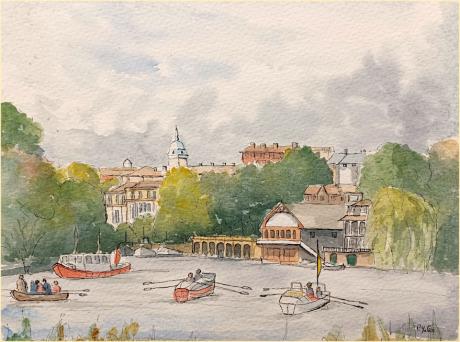" P Yates"
Unframed
Regattas have been held at Richmond for many centuries but the modern event was started in 1950 to commemorate the Diamond Jubilee of the Borough of Richmond.
The very earliest reference dates back to 1735, making Richmond not quite the oldest regatta we know of, honours there go to Chester Regatta by a bowball, as it claims a history back to 1733. I am unsure of the provenance, but the regatta website tells us that in 1776, the year of American Declaration of Independence,
A Regatta was celebrated on the River Thames between Richmond and Kew in honour of the Prince of Wales’ birthday. Their Majesties, and all the rest of the Royal Family were present and received by all ranks with the greatest marks of Affection and Respect: but excepting the number of boats and the crowds of people the show afforded little diversion. In the evening some very curious fireworks were displayed on an ait on the River Thames which had a very fine effect.
Assuming the report is reliable, the Prince of Wales in 1776, would have been George, later George IV. His birthday was 12 August – a very suitable time of year for a regatta. The reference to royal attendance at a regatta is interesting, because in the archives of the present-day Richmond Amateur Regatta is a programme printed on silk for the “Second Annual Richmond Junior Watermen’s Royal Regatta” which “respectfully informs … The Nobility, Gentry and Inhabitants generally of Richmond … that a ROWING MATCH will be contested on Monday, the 9th day of August 1869 BY FREE WATERMEN OF RICHMOND”.
The prize for this contest was declared to be “a purse of sovereigns … And other prizes …”. If we assume that sovereigns plural, means at least two sovereigns (and probably quite a few more) then this is a very worthwhile reward.
Although obviously intrigued by both the duck hunt and the pig hunt my attention turns first to the “canoe racing, by Watermen’s sons” for the prize of a suit of clothes. I presume unrelated but on display at my rowing club, Auriol Kensington in Hammersmith, is a red “Richmond Royal Regatta” coat and badge, won by HJ Cole in 1921, very similar in style to a Doggett’s Coat & Badge.
Secondly, we turn to the programme of Watermen’s and Apprentice Watermen’s races. Based on how the programme is laid out with three pairs of names against each heat, I assume that the races were in double skiffs, raced three abreast. Amongst the Watermen named on the programme, we find Thomas Young, Doggett’s winner in 1863 and amongst the apprentices are Thomas Mackinney (went on to win the Doggett’s in 1871) and Henry Messum (Doggett’s winner in 1873). I should very much like to see the results from Richmond, 1869.
The course in 1869 is described as “Start from Richmond Bridge down round a Boat moored off St. Margaret’s, up round a Boat moored off the Duke of Buccleugh’s, and finish at the Bridge.” This is all in the stretch downriver from the course used by today’s Richmond Amateur Regatta. The finish line of the modern regatta is at Buccleugh Gardens (presumably the “Duke of Buccleugh’s” in the 1869 programme) and the start is 1250 metres further upriver by Ham House.
From its heyday in the 19th century, the fortunes of Richmond Regatta have waxed and waned, including as a series of Boxing Day Regattas (one of which can be seen on a film from Pathé News). The modern Richmond Amateur Regatta was resurrected in 1950 as part of the borough Diamond Jubilee.
Richmond is a traditional river regatta – crews race side by side 1250 metres downstream from the start by Ham House. The course is not, shall we say, quite straight, and, as a consequence, both the start and the finish are staggered in order to offset the shorter course experienced by the crew on the inside (Middlesex) station. The stagger on the finish has caught out many a crew who have relaxed too soon believing they were comfortably ahead.

